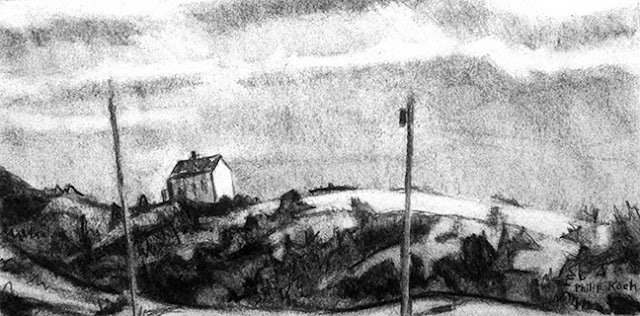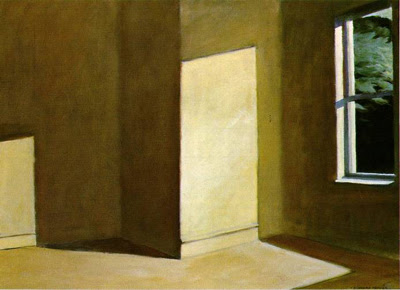Visiting The Masters Exhibition at Somerville Manning Gallery
Charles Burchfield's watercolor August Morn hanging on
the Sommerville Manning Gallery wall yesterday.
One of the ways you know a painting is good is that instead of tiring of it you grow more curious about it over time.
Yesterday we drove up from Baltimore to Greenville, Delaware and visited Sommerville Manning Gallery. Each year they mount an exhibit that's especially worth seeing, American and European Masters . One of pieces they included is the Charles Burchfield watercolor August Morn, 1933-49. By coincidence before I learned the painting was going to be on display at one of my art galleries I had written a blog post about the painting. The temptation to see it again in the flesh was too strong to resist.
Rebecca Moore from the Gallery and I enjoyed closely going over the painting together. Since becoming the Artist in Residence at the Burchfield Penney Art Center in Buffalo, NY I've had the opportunity to examine Burchfield's paintings and drawings first hand. A revelation for me was how often Burchfield loved to go back into his earlier work and develop it further. He painted the central section of the painting in 1933. But revisiting it years later he decided he could take it to a higher level by enlarging it.
The seam where he joined an additional 4" tall panel of paper at the top of the painting is visible if one looks closely at the large white cloud at the right. What I hadn't realized is he also placed smaller additions at the left, right and bottom as well. The seams where he joined these panels are made almost completely invisible by agitated brushwork in the foliage he's built up around the edges of his enlarged composition.
Sixteen years after the piece was begun it was completed at a more grand scale. Rebecca and I talked about how Burchfield himself had evolved over these years. The middle section from 1933 was a straightforward view of his next door neighbor's house in Gardenville, NY. Typical of the work he did at that time it's all about solid volumes and establishes clear highlights and cast shadows of the roofs and walls. His later additions focus more densely patterned celebrations of Burchfield's garden. That he can marry these subtly differing styles of painting so well testifies to his remarkable talents.
The American and European Masters show is well worth a visit- it runs through June 4.
I'm attracted to Burchfield's work because he and I are sort of chewing on the same bone. Two of my paintings at Sommerville Manning Gallery are like the August Morn in the way they take a close up look at the almost surreal patterns of growth that I discovered in tree trunks and branches in my wanderings through the forest.
My painting Thicket was done from a group of young white birch trees I discovered in Acadia National Park in Maine. They seemed to do a dance together to a rhythm only they could hear. There is an almost painful fresh innocence to groves of young birches like these.
Philip Koch, Deep Forest Pool, oil on panel, 15 x 20", 2014
One of the themes Charles Burchfield often played with is the cycles of life from youth to maturity to old age. In my oil Deep Forest Pool I depicted the second half of this cycle, with mature birch trees bending and clanking their way upwards on the pond's far shore while two fallen birches slowly submerge in the inky dark waters.
Philip Koch, Memorial, oil on panel, 18 x 36", 2010
Burchfield in much of his work relied more on memory and fantasy than on direct observation. My painting Memorial is a reverie of the countless times I've lost myself in deep spaces looking out from mountain tops at the earth's expanse. This painting is based on my memories of the islands surrounding Mt. Desert Island in Maine. It was done entirely from memory and shows the scene under the pale light of a full moon.







